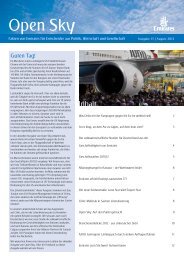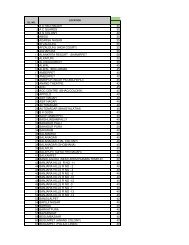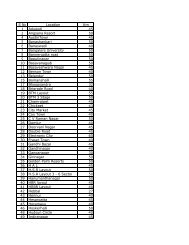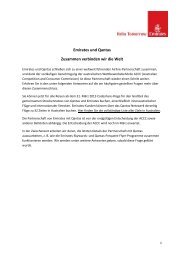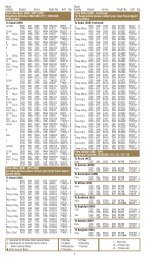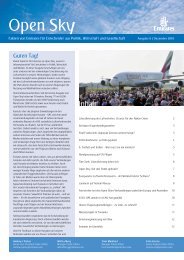Annual Report 2008-2009 - Emirates.com
Annual Report 2008-2009 - Emirates.com
Annual Report 2008-2009 - Emirates.com
You also want an ePaper? Increase the reach of your titles
YUMPU automatically turns print PDFs into web optimized ePapers that Google loves.
1. Establishment and operations<br />
Notes to the consolidated financial statements<br />
for the year ended 31 March <strong>2009</strong><br />
Dnata <strong>com</strong>prises Dnata and its subsidiaries. Dnata was incorporated in the emirate of Dubai, UAE with limited liability, under an Emiri<br />
Decree issued by H.H. Sheikh Maktoum bin Rashid Al-Maktoum on 4 April 1987. On that date, the total assets and liabilities of Dubai<br />
National Air Travel Agency were transferred to Dnata, with effect from 1 April 1987, for nil consideration. Dnata is wholly owned by the<br />
Investment Corporation of Dubai, a Government of Dubai entity.<br />
Dnata is incorporated and domiciled in Dubai, UAE. The address of its registered office is Dnata Travel Centre, Sheikh Zayed Road, PO<br />
Box 1515, Dubai, UAE.<br />
The main activities of Dnata <strong>com</strong>prise:<br />
aircraft handling and engineering services<br />
handling services for export and import cargo<br />
information technology services<br />
representing airlines as their general sales agent<br />
travel agency and other travel related services<br />
inflight and institutional catering<br />
2. Summary of significant accounting policies<br />
A summary of the significant accounting policies, which have been applied consistently, is set out below.<br />
Basis of preparation<br />
The consolidated financial statements have been prepared in accordance with and <strong>com</strong>ply with International Financial <strong>Report</strong>ing<br />
Standards. The consolidated financial statements are prepared under the historical cost convention.<br />
Standards, interpretations and amendments to published standards that are not yet effective, have not been early adopted and<br />
are relevant to Dnata’s operations<br />
At the date of authorisation of these financial statements, certain new standards, interpretations and amendments to the existing<br />
standards have been published that are mandatory for accounting periods <strong>com</strong>mencing on or after 1 January <strong>2009</strong>. Management is<br />
currently assessing the following standards, interpretations and amendments which are likely to have an impact on Dnata’s operations:<br />
IFRS 3 (Revised), Business <strong>com</strong>binations (effective from 1 July <strong>2009</strong>)<br />
IFRS 8, Operating segments (effective from 1 January <strong>2009</strong>)<br />
IAS 1 (Revised), Presentation of financial statements (effective from 1 January <strong>2009</strong>)<br />
IAS 19 (Amendment), Employee benefits (effective from 1 January <strong>2009</strong>)<br />
IAS 23 (Amendment), Borrowing costs (effective from 1 January <strong>2009</strong>)<br />
IAS 27 (Revised), Consolidated and separate financial statements (effective from 1 July <strong>2009</strong>)<br />
IAS 28 (Amendment), Investment in associates (effective from 1 January <strong>2009</strong>)<br />
IAS 36 (Amendment), Impairment of assets (effective from 1 January <strong>2009</strong>)<br />
IAS 38 (Amendment), Intangible assets (effective from 1 January <strong>2009</strong>)<br />
IAS 39 (Amendment), Financial instruments (effective from 1 January <strong>2009</strong>)<br />
Basis of consolidation<br />
Subsidiaries are those entities in which Dnata has the power to govern the entity’s operating and financial policies generally<br />
ac<strong>com</strong>panying a shareholding of more than one half of the voting rights. Subsidiaries are consolidated from the date on which control is<br />
transferred to Dnata and are no longer consolidated from the date on which control ceases. All material inter-<strong>com</strong>pany transactions,<br />
balances and unrealised gains and losses arising on transactions between Dnata and its subsidiaries are eliminated.<br />
The purchase method of accounting is used to account for the acquisition of subsidiaries. The cost of an acquisition is measured as the<br />
fair value of assets given and liabilities incurred or assumed at the date of exchange, plus costs directly attributable to the acquisition.<br />
Identifiable assets including intangible assets acquired, liabilities and contingent liabilities assumed in a business <strong>com</strong>bination are<br />
measured at their fair values at the acquisition date.<br />
117






